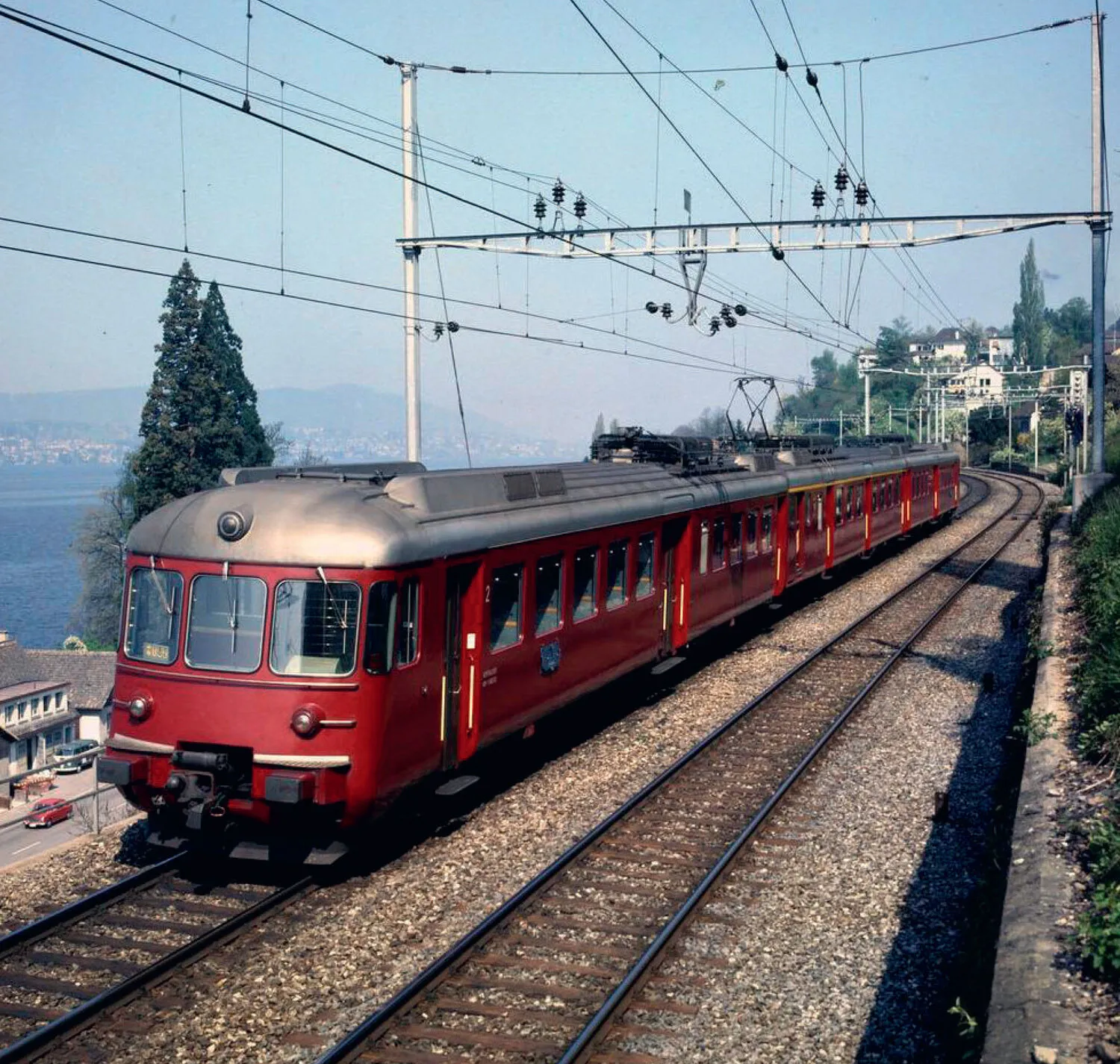Vehicle type:
Registration country:
1965
The "fixed timetable" concept - now known as a regular-interval timetable, already well-proven by the city’s transport operators, was applied to the railway service. Trains were to run at 30-minute intervals, always at the same time of day.
To meet the mentioned requirements, it was clear that only specialised rolling stock with high acceleration would be suitable.
Only specialized rolling stock could meet the strict operational requirements, and the short distances between stations required high acceleration and braking performance. Therefore, in 1963, after a design competition, the SBB decided to purchase three-part electric trains with twelve powered axles. The trains were controlled in multiple-unit operation, and in some cases, up to four units were operated by a single driver. The vehicles featured construction elements similar to the Unified Coaches I.
The SBB (Swiss Federal Railways) decided to purchase twenty three-car trains with full traction to meet the high standards required. The companies Schindler Waggon AG Pratteln (SWP), Flug- und Fahrzeugwerke Altenrhein AG (FFA), Société Anonyme des Ateliers de Sécheron (SAAS), and Brown, Boveri & Cie (BBC) were commissioned to build the vehicles and delivered the RABDe 12/12 1101 - 1120 between March 1965 and April 1967.
The companies Georg Fischer (GF) and Bührle & Cie built the "GF" couplings. For the transfer of vehicles between the various manufacturing workshops, the Be 4/6 1615 locomotive was temporarily equipped with "GF" couplings.
The service weight was 170 tons (57/56/57 tons per vehicle), and the maximum speed was 125 km/h. The three-part trains had 56 seats in first class, 144 in second class, and 160 standing places. The seats and interior design were largely based on those of the EW I coaches. Additionally, a 10 m² luggage area was available in the middle car. At the central entry platforms in the end cars, there was a metal column serving as a handrail. Inside this column was the cable carrying the 15,000 volts of overhead power from the roof equipment to the transformer under the car.
Initially, the trains were painted in a bright wine-red with a silver roof, which was later changed to dark gray.
Provisional handovers for test and special journeys began in March 1965 for train 1101 and in May 1965 for train 1102, with one train being delivered each month. Train 1101 was extensively tested on the Geneva-Lausanne, Bern-Fribourg-Palézieux, and Bern-Thun routes, and on September 29, the press was invited for a test run. At the end of December, the first test run took place at night between Zurich, Meilen, and Rapperswil. During this early phase, various special trips were also made across Switzerland.
From the 1965/1966 timetable onwards, the trains were partially put into service on the Zurich-Meilen-Rapperswil route. However, the deployment was too optimistic, as the acceleration at higher speeds had to be reduced because the power supply was not designed for such high acceleration. As a result, additional transformers and traction current return lines had to be installed on the route. This was completed between January 1967 and January 1968, and by the 1967/1968 timetable, the situation had stabilized. The first official S-Bahn of the SBB was then inaugurated, and the trains could fully operate on the Zurich-Meilen-Rapperswil and Uster routes in double and triple traction. Additionally, from June 1st, 1967, a RABDe 12/12 replaced the bath trains between Zurich via Bülach and Zurzach, marking the last scheduled use of the "Red Arrow".
During the severe winter of January 1968, the trains proved their worth and were used between Glarus and Linthal and as a replacement for the ÖBB “Transalpin” between Zurich and Basel.
By the 1970/1971 timetable, full operation with 16 services and 20 trains was introduced on their main route. Some trains also regularly traveled to Linthal, Horgen, Oberdorf, Zurzach, and Bülach.
NB: These trains earned the nickname "Mirage" due to their rapid acceleration, inspired by the Swiss Army’s acquisition of "Mirage" fighter jets at the same time these units were procured. Some units were also nicknamed “Goldküstenexpress” (Gold Coast Express) as they operated on the right bank of Lake Zurich, a sunny area with very high property prices, also known as the "Gold Coast".
Sources: LocoFolio 2009/1
1971
on January 18th, trains 1109 and 1119 collided in Feldmeilen, after which train 1119 was taken out of service (one of the rear cars was used to reconstruct train 1109);
on March 25th, another collision occurred in Uerikon resulting in the scrapping of train 1117 (one of the rear cars was used to reconstruct train 1113).
NB: trainset 1120 is renumbered as 1117II.
Sources: https://en.wikipedia.org/wiki/SBB-CFF-FFS_RABDe_12/12
1982
1982
September 12
Sources: LocoFolio 2009/1
1990
Sources: LocoFolio 2009/1
1996
Sources: https://en.wikipedia.org/wiki/SBB-CFF-FFS_RABDe_12/12
Do you have additional informations regarding this vehicle?
Help us writing the history of RABDe 12/12 "Mirages"! Your knowledge is precious for us and the entire community, do not hesitate to share your facts, photos or videos:
Latest update on the 20th of October 2024 at 16:05
Contributor(s): Tudor C.
Discussion forum





